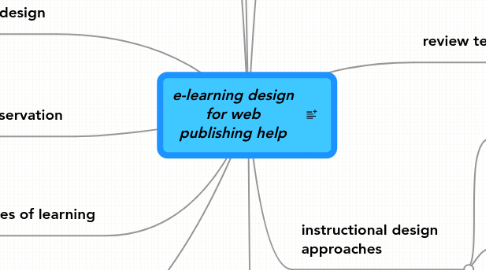
1. social semiotic model
1.1. Writing reports http://www.usyd.edu.au/learningcentre/wrise/
2. My Geistesblitzes
2.1. Check out http://www.mindmeister.com/services/tools/geistesblitz_widgets
3. participatory design
3.1. object-centred sociality http://www.zengestrom.com/blog/2005/04/why_some_social.html
3.2. social objects http://museumtwo.pbworks.com/Chapter-4%3A-Social-Objects
3.3. crowdsourcing design http://nlablog.wordpress.com/2009/07/17/crowdsourcing-design-what-will-this-mean-for-museums/
4. 'product' specifications
4.1. DESIGN GUIDELINES
4.1.1. interaction design http://www.uie.com/articles/user_expectations/
4.1.2. immediate feedback - see the result of what they have made in context
4.2. COMMUNITY BUILDING
4.2.1. form to enter question on how to or where to use this feature
4.2.2. nominate self or others for good use of tool
4.2.3. recently added items of this type
4.3. STUFF TO LEARN
4.3.1. sequence of steps to create item
4.3.2. attitude change - improve value to client
4.3.2.1. accessible to all users
4.3.2.2. findable - good metadata, good chunking
5. workplace observation
6. theories of learning
6.1. flow http://www.ted.com/talks/mihaly_csikszentmihalyi_on_flow.html
6.2. Tom Wujec How the brain creates meaning http://www.ted.com/talks/tom_wujec_on_3_ways_the_brain_creates_meaning.html
6.3. scaffolding - how much frontloading is required for this task? what about attitude change?
7. workplace context
7.1. setting: large state government department
7.2. aim: do-it-yourself web publishing
7.3. personal learning goals
7.3.1. 43things.com http://www.43things.com/person/pennyjw
7.3.2. learn more about visualisation
7.3.2.1. collect models
7.4. learners: staff and contractors,adult, internal setting, adequate IT skills
7.5. constraints: learners geographically distributed; remote from face-to-face help; disparate interests
7.6. risks: publishing to external audience, damage to government reputation
7.7. barriers: no help from standard IT helpdesk
8. instructional design approaches
8.1. Use toolbar to add ideas
8.2. Learning objects
8.2.1. conole - Cultural Historical Activity Theory
8.2.2. defintion - Wiley
8.2.3. ENTER to add siblings
8.2.4. DEL to delete
8.2.5. All key shortcuts
8.3. Find out more? Try http://www.mindmeister.com/help
9. review team
9.1. learners
9.2. programmer
9.3. web master
9.4. internal communication
9.5. staff training
10. mentoring science writing
10.1. CONTEXT
10.1.1. context of organisation
10.1.1.1. academic; cross-discipline project; CityU English is L2; USyd markers may be English L1 or L2
10.1.2. context of communication
10.1.2.1. students are apprenticed in a discipline-specific genre
10.1.3. context of science
10.1.3.1. academic writing characteristics valued in science: objectivity; brevity; relevance; evidence
10.2. ACTIVITIES
10.2.1. flexible
10.2.1.1. feedback is text only: no provision for different learning styles
10.2.2. pedagogy
10.2.2.1. strong pedagogical model for process and directed outcomes
10.2.3. opportunities for learning
10.2.3.1. asynchronous; detailed individualised feedback
10.3. INTEGRATION
10.3.1. constructive environment
10.3.1.1. learners create their own representation of course content
10.3.2. integration
10.3.2.1. training in genre-first assessment integrated with technical training
10.3.3. adding value
10.3.3.1. quick turnaround in marking allows multiple versions, timely feedback
10.4. COLLABORATION
10.4.1. collaboration
10.4.1.1. no collaboration between students
10.4.2. cooperation
10.4.2.1. learning model is non-cooperative
10.4.3. communication
10.4.3.1. communication between instructors and students is highly regulated
10.5. SHARED SPACES
10.5.1. shared space
10.5.1.1. instructors support instructors
10.5.1.2. dialogues: between expert and markers; otherwise no
10.5.1.3. reflection - yes, for instructors, project is action research
10.5.1.4. observing best practice - students' best writing provides models for others
10.5.1.5. taking risks
10.5.2. making connections
10.5.2.1. links to real-life - applicable to all science writing tasks in general

